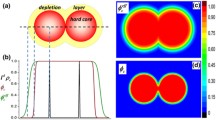Abstract
The paper deals with important differences in the distribution of free volume in high and low free volume polymers as indicated by a joint investigation utilizing molecular modeling and positron annihilation lifetime (PALS) studies. The main focus of this paper is on the molecular modeling approach. The first set of polymers in question are the ultra-high free volume polymer poly(1–(trimethylsilyl)-1-propyne) (PTMSP) and two polystyrene derivatives containing Si and F. Extended equilibration procedures were necessary to obtain reasonable packing models for the polymers. The transition state Gusev-Suter Monte Carlo method was utilized to prove a reasonable agreement between simulated and measured diffusivity and solubility values for the model structures. The free volume distribution was analyzed for the validated packing models and compared with respective PALS data. In both cases a bimodal distribution of free volume was observed for PTMSP while the polystyrene derivatives as other conventional glassy polymers showed a more or less monomodal behavior. Good qualitative agreement is demonstrated between size distributions of free volume elements in these polymers obtained via molecular computer modeling and PALS experiments. In addition a series of conventional and high performance polyimides was considered. There a major result is that polyimides with conventional permeabilities for small molecules always show just a monomodal distribution of free volume element sizes in the radius range up to about 5 Å, while all polyimides with high permeabilities have a wider, often bimodal, distribution extending up to a radius between 6 and about 8 Å.
Similar content being viewed by others
References
P. A. Belter, E. L. Cussler and W. S. Hu, Bioseparations: Downstream Processing for Biotechnology, (John Wiley & Sons, New York, NY, 1988).
J. S. Kim, S. Akeprathumchai and S. R. Wickramasinghe, J. Membr. Sci. 182, 161–172 (2001).
S. R. Wickramasinghe, Y. Wu and B. Han, Desalination 147, 25–30 (2002).
P. T. Spicer and S. E. Pratsinis, AIChE J. 42 (6), 1612–1620 (1996).
N. Tambo and Y. Watanabe, Water Res. 13, 429–439 (1979).
C. F. Lu and L. A. Spielman, J. Colloid Interf. Sci. 103 (1), 95–105 (1985).
I. Reich and R. D. Vold, J. Phys. Chem.-US 63, 1497–1501 (1959).
D. Ramkrishna, Population Balances: Theory and Applications to Particulate Systems in Engineering, (Academic Press, New York, NY, 2000).
J. Abrahamson, Chem. Eng. Sci. 30 (11), 1371–1379 (1975).
J. D. Pandya and L. A. Spielman, J. Colloid Interf. Sci. 90 (2), 517–531 (1982).
A. N. Kolmogoroff, C. R. Acad. Sci. (Doklady) URSS, XXX1, 99–101 (1941).
R. D. Vigil and R. M. Ziff, J. Colloid Interf. Sci. 133 (1), 257–264 (1989).
Author information
Authors and Affiliations
Rights and permissions
About this article
Cite this article
Hofmann, D., Heuchel, M., Yampolskii, Y. et al. Molecular Modeling of Free Volume Distributions of Amorphous Membrane Polymers. MRS Online Proceedings Library 752, 74 (2002). https://doi.org/10.1557/PROC-752-AA7.4
Published:
DOI: https://doi.org/10.1557/PROC-752-AA7.4




